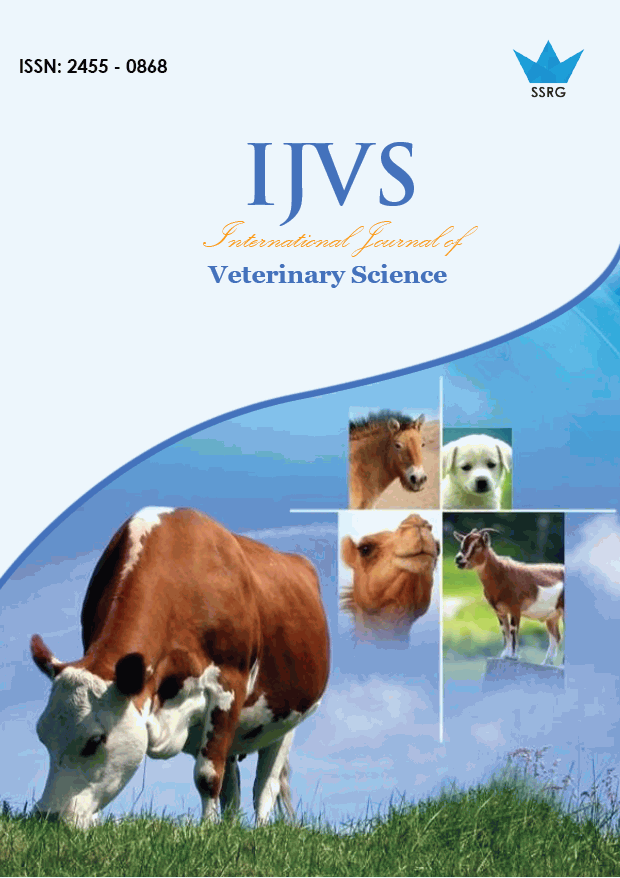Restenosis Subsequent to Inflate Valvuloplasty in Dogs with Inherited Pulmonary Stenosis

| International Journal of Veterinary Science |
| © 2015 by SSRG - IJVS Journal |
| Volume 1 Issue 1 |
| Year of Publication : 2015 |
| Authors : Dr.G.Jonesneelu, V.Sowmiya barveen |
How to Cite?
Dr.G.Jonesneelu, V.Sowmiya barveen, "Restenosis Subsequent to Inflate Valvuloplasty in Dogs with Inherited Pulmonary Stenosis," SSRG International Journal of Veterinary Science, vol. 1, no. 1, pp. 11-14, 2015. Crossref, https://doi.org/10.14445/24550868/IJVS-V1I1P104
Abstract:
The aspire of this learning were to expose the pervasiveness of complications connected with PBV in excess of a long-term follow-up, and to examine the factors interrelated to those complications, particularly pulmonary Restenosis. Forty dogs that undergo PBV were with the benefit of hindsight reviewed. Long-term follow-up was available in 26 dogs. Exacerbation of PI and TR after PBV was observed in some dogs; however, right-sided heart failure due to PI or TR was not observed in any of them. During long-term follow up, Restenosis developed in 7 dogs (7/25). Restenosis was noticed 5.5 after successful PBV. Numerous regression analyses recognized atenolol administration proceeding to PBV as the autonomous predictor of Restenosis all through long-term follow-up. Supplementary search is defensible to investigate the apparatus of Restenosis and to conclude an approach to thwart complications.
Keywords:
Pulmonary valve stenosis, Long-term follow-up, Atenolol.
References:
1. Hiroshi Sunahara, Yoko Fujii, Keisuke Sugimoto, Takuma Aoki, Restenosis After Balloon Valvuloplasty in Dogs with Congenital Pulmonary Stenosis, International Journal of Application Res Veterinary Medicine, Vol. 12, No. 2, 2014.
2. Oliveira P, Domenech O, Silva J, et al. Retrospective review of congenital heart disease in 976 dogs. J Vet Intern Med; 25: 477-483, 2011.
3. Bussadori C, DeMadron E, Santilli RA, et al. Balloon Valvuloplasty in 30 dogs with pulmonic stenosis: effect of valve morphology and annular size on initial and 1-year outcome. J Vet Intern Med; 15: 553-558, 2001.
4. Francis AJ, Johnson MJ, Culshaw GC, et al. Outcome in 55 dogs with pulmonic stenosis that did not undergo balloon Valvuloplasty or surgery. J Small Anim Pract, 52: 282-288, 2011.
5. Peterson C, Schilthuis JJ, Dodge-Khatami A, et al. Comparative long-term results of surgery versus balloon Valvuloplasty for pulmonary valve stenosis in infants and children. Ann Thorac Surg; 76: 1078-1082, 2003.
6. Locatelli C, Domenech O, Silva J, et al. Independent predictors of immediate and long-term results after pulmonary balloon Valvuloplasty in dogs. J Vet Cardiol; 13: 21-30, 2011.
7. Yang H, Pu M, Chambers CE, et al. Quantitative assessment of pulmonary insufficiency by Doppler echocardiography in patients with adult congenital heart disease. J Am Soc Echocardiogram; 21: 157-164, 2008.
8. Guo Y, Zeng QC, Zhang CQ et al. Extracellular matrix of mechanically stretched cardiac fibroblasts improves viability and metabolic activity of ventricular cells. Int J Med Sci; 10: 1837- 1845, 2013.

 10.14445/24550868/IJVS-V1I1P104
10.14445/24550868/IJVS-V1I1P104